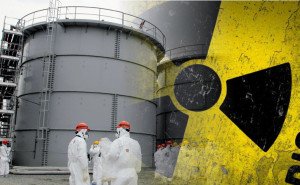 10am, 5.9.13: Japan’s government will pour $500 million into an attempt to contain and treat contaminated water at the site of the Fukushima Daiichi nuclear power plant, after revelations last month that large volumes of radioactive water continue to leak into the ocean.
10am, 5.9.13: Japan’s government will pour $500 million into an attempt to contain and treat contaminated water at the site of the Fukushima Daiichi nuclear power plant, after revelations last month that large volumes of radioactive water continue to leak into the ocean.
The UK Science Media Centre has rounded up the following expert comments on the radioactive water leak and proposed method of containment:
Prof Richard Wakeford, Visiting Professor at the Dalton Nuclear Institute, University of Manchester, said:
“It is inevitable that in the complex recovery operations taking place at the Fukushima Dai-ichi nuclear power station inadvertent incidents involving the release of radioactive materials will occur. When confined to the site (e.g. ground contamination from a leaking pipe), it is important to identify such incidents quickly through a comprehensive radiation monitoring programme so that workers are protected, and it is necessary to distinguish between the types of radiation emitted from such contamination – weakly penetrating beta-radiation (unlike penetrating gamma-radiation) is a problem only if taken into the body or if contamination comes into contact with bare skin.
Off-site leakage of radioactive material is clearly undesirable and needs to be brought under control as soon as possible, but a careful balance has to be sought between keeping cooling water flowing over the damaged reactor fuel and the consequent level of leakage of contaminated water into the environment. Despite the difficulties faced, the situation is now much improved over that existing 2½ years ago – iodine-131, of substantial concern then, has now all decayed away – but much work needs to be done to find appropriate solutions to the problems still faced, which is perhaps not surprising after such a serious accident.”
Professor Neil Hyatt, Professor of Radioactive Waste Management, University of Sheffield, said:
“The idea of the freeze wall concept is to chill a salt water solution below the melting point of ice and then pump this through underground pipes. This causes the local groundwater to freeze, forming a barrier to the movement of contaminated ground water. A similar process is used in underground uranium mining, to prevent flooding of a working area at depth, so the basic engineering principles are quite well understood. However, this is a very energy intensive process to maintain, so there will need to be careful design and trial work to produce an effective barrier that minimises energy demand.
“The urgent challenge, in terms of reducing the on-site hazard of radioactive water storage, is to deploy additional decontamination units, so the water can be discharged under environmental regulations. Then, the material in the decontamination units themselves will require stabilisation, for example as a glass or ceramic, in order to be suitable for long term storage. There is considerable expertise in the UK that could assist the R&D effort, in this respect.”
Professor Malcolm Sperrin, Director of Medical Physics and Clinical Engineering, Royal Berkshire Hospital, said:
“The step being taken by TEPCO to freeze the ground in order to prevent ground water transport of isotopes is certainly an interesting approach. It must be considered a temporary solution since there will be a considerable cost and effort required to freeze the ground and then to keep it frozen. However, factors to take into account will include passage of isotopes through the frozen wall (since it is likely to be porous), passage of isotopes around and underneath the ice wall, and, even if the ice wall is impervious, the contaminated ground water will eventually build up and flow around the barrier.
“Some work has been done to examine the use of frozen ground as containment in non-radioactive applications but there are very many factors which affect its efficacy.”
Professor Paddy Regan, Professor of Nuclear Physics, University of Surrey, said:
“A dose level of 1800 millisieverts per hour is certainly a very high radiation dose, which would be fatal to most people who were exposed to this for more than a couple of hours. What needs to be clarified from the measured data is (a) what is the nature of the radioactive material which is giving this dose (i.e. gamma emitters such as cesium-134 (134Cs) and cesium-137 (137Cs) and/or pure beta emitters such as strontium-90); and (b) at what distance from the source this dose rate was measured at. Simply put, as one stands further away from the source, the exposed dose reduces significantly. I assume that most of the radioactive dose as measured at the site arises from beta-delayed gamma-emitters such as 137Cs and 134Cs. These radionuclides are straightforward to identify and track as they emit characteristic energy signals, which, like a fingerprint, can be associated with these specific radioisotopes.
“One issue is the storage of this material locally on site at Fukushima, which is a short, rather than long term solution. While the material is stored, the activity (particular of the 134Cs) reduces significantly over time (the half-life for this radionuclide is approximately 2 years). The 137Cs half-life is approximately 30 years so remains radioactive for significantly longer. The amount of 137Cs held in these tanks is a tiny fraction of the 137Cs which has been dispersed into the Geosphere from the more than 400 atmospheric nuclear weapons tests since the war, and significantly smaller than was released at Chernobyl. The issue of what to do with the stored ‘radioactive’ water at Fukushima is a serious one, but needs to be contextualised in terms of the relative amounts of radioactive material present compared to the global inventory.”
Earlier SMC expert comments and resources on Fukushima can be found here.